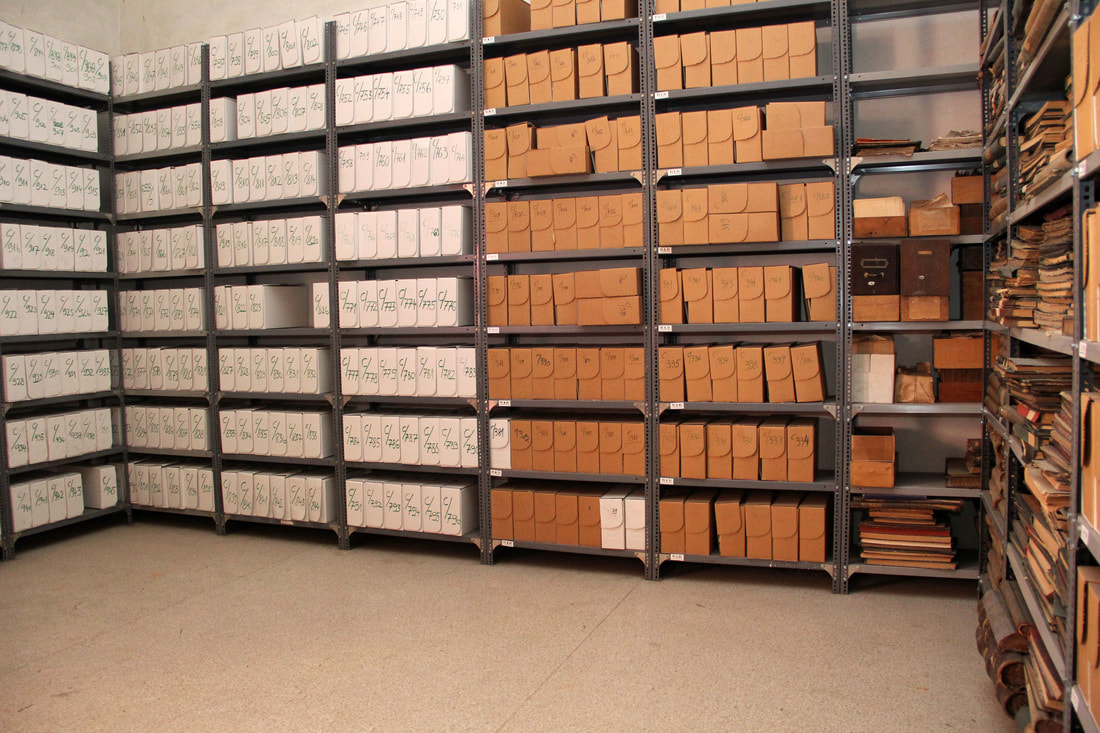|
A Magyar Zsidó Levéltár létrehozását már 1943-ban szorgalmazták a múzeum dolgozói, de végül csak 1972-ben nyílt meg hivatalosan, az Országos Rabbiképző Intézetben, Scheiber Sándor és Landeszmann György fáradozásainak köszönhetően. 1994-ben az ott őrzött, zömmel a holokuaszt során elnéptelenedett hitközségektől összegyűjtött iratanyagot egyesítettük a múzeumban gyűjtött történelmi jelentőségű, művészien megformált iratokkal: díszes hevrakönyvekkel, szimbolikus fontosságú dokumentumokkal. Ezek egyesítése, rendezése, minél alaposabb jegyzékelése azóta is folyamatos munkát ad a kollégáknak. A rendszerváltást követően a Dohány utcai zsinagóga felújítása során a zsinagóga egy "világtól elzárt" emeleti termében rábukkantunk még egy hatalmas halom iratra - ez akkor ugyan örömet is jelentett, de sokkoló is volt. Akkor nem készítettünk fényképeket, csak 2009-ben, amikor végül nekiláttunk ezek rendezésének is. Akkor ilyen volt: The establishment of the Hungarian Jewish Archives was advocated by the museum staff as early as 1943, but it was only officially opened in 1972, at the National Rabbinical Training Institute, thanks to the efforts of Sándor Scheiber and György Landeszmann. In 1994, the archival material kept there, mostly collected from parishes that had been depopulated during the Holocaust, was combined with the museum's collection of historically significant, artistically sculpted documents: ornate hymnals, documents of symbolic importance. The process of combining, organising and cataloguing them as thoroughly as possible has been a constant source of work for our colleagues ever since. During the renovation of the Dohány Street synagogue after the fall of communism, we discovered another huge pile of documents in an upstairs room of the synagogue, "closed to the world" - a joyful but shocking discovery. We didn't take any photographs then until 2009, when we finally started to sort them out. It was like that: Mivel a káosz elképesztő volt, így nem úgy dolgoztunk, mint általában a levéltárak (X szervezet iratai ettől eddig, x méternyi terjedelemben) - hanem minden egyes dokumentumot egyenként kézbe kellett venni, elolvasni (ez legalább három nyelvet és írásrendszert jelent!) és leírni. Az iratokat egyenként írtuk le, és ezt követte - és ezen még mindig dolgozunk - az iratok fondokba, azaz nagyobb egységekbe csoportosítása. De közben rend lett, az iratok már biztonságban, savmentes dobozokban vannak, és megszűnt az a veszély, hogy múltunk egy fontos szelete örökre megismerhetetlenné válhat. (Ehhez támogatásokból polcokat és dobozokat vásároltunk, és kiépítettük a terület tűzjelző rendszerét is.) Kiderült az is, hogy ez az iratanyag Európa legteljesebb egységben megmaradt zsidó közösségi levéltára! Ma így néz ki a raktár: As the chaos was astonishing, we didn't work like archives usually do (X organization's documents so far, x meters in length) - but each document had to be taken in hand, read (that means at least three languages and writing systems!), and written down. The documents were written down one by one, and then - and we are still working on this - the documents were grouped into fonds, i.e. larger units. But in the meantime, the documents are now in safe, acid-free boxes, and there is no longer any danger that an important part of our past will be lost forever. (We have bought shelves and boxes with grants and set up a fire alarm system in the area.) It also became clear that this archive is Europe's most complete surviving Jewish community archive! This is what the repository looks like today: Az iratok jegyzéke elérhető a fondjegyzékből innen. Köszönet a munkában részt vevő kollégáknak, önkénteseknek, és persze a támogatóknak: a Unites States Holocaust Memorial Museum-nak, és a Rothschild Foundation Europe-nak. The list of documents is available from the list of fonds here. Thanks to all colleagues, volunteers and of course to the sponsors: the Unites States Holocaust Memorial Museum and the Rothschild Foundation Europe. |
A Magyar Zsidó Múzeum és Levéltár hírei
Archives
February 2024
Categories |

 RSS Feed
RSS Feed